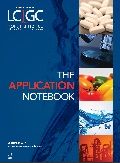Liposome Size, Concentration, and Structural Characterization by FFF-MA LS-DLS
The Application Notebook
Liposomes are often used as nanocarriers to encapsulate in their cores hydrophobic or highly toxic drugs, and deliver these drugs safely to target tissue. During drug nanocarrier research and development as well as production quality control, it is of great importance to monitor liposome size distributions accurately while also verifying drug encapsulation. FFF-MALS-DLS, consisting of field-flow fractionation (FFF) combined with multi-angle light scattering (MALS) and dynamic light scattering (DLS), is a powerful tool for characterizing the size, concentration and structure of large nanoparticle ensembles.
Method
Encapsulation might cause changes in liposomal dimensions, but that is not always the case and other effects could cause such changes. Therefore, a more sophisticated analysis is warranted than mere size. Here, we report the analyses of two liposome samples, one empty and one filled with drug, by means of an Eclipse® FFF system followed by a DAWN® MALS detector with embedded WyattQELS™ DLS module. The WyattQELS detector was placed at approximately 143° in order to extend the rh measurement to well over 60 nm. The FFF separation method was optimized with the aid of Wyatt's proprietary FFF simulation software. ASTRA software was used to collect and analyze the light scattering data to determine size and concentration (number density).
Results and Discussion
FFF separates particles according to hydrodynamic radius. Thanks to upstream separation, quantitative size distributions by FFF-MALS-DLS provide far more resolution and quantification than does batch (unfractionated) DLS. Online DLS directly measures the hydrodynamic radius rh sequentially for each eluting size fraction, while MALS measures simultaneously the root-mean square radius rg.
Both rg and rh are plotted against elution time in Figure 1. The results from duplicate runs demonstrate clean separation and excellent reproducibility of the FFF-MALS-DLS method. Figure 1a shows that the rh values for both empty and filled liposomes are well-overlaid, suggesting that drug loading does not impact hydrodynamic size. However, as shown in Figure 1b, rg values for these two liposomes do not overlay, which indicates different internal structures.

Figure 2a plots rg against rh; ρ is the slope of the linear fit. The values of ρ for these two populations correlate precisely to empty and filled liposomal structures. In addition to size and structure, FFF-MALS can determine quantitative size distributions (number density vs. size) of size-fractionated nanoparticles if the refractive index of the constituent material is known. For lipids this is quite straightforward and Figure 2b provides the quantitative nanoparticle concentration analysis.

Conclusion
For liposomes or other nanoparticles, FFF-MALS-QELS provides an easily adaptable yet powerful characterization tool to obtain information on particle size, size distribution, particle count, as well as structure-all without making assumptions about the particles or their composition. FFF-MALS-DLS instrumentation is essential for robust drug nanocarrier development and quality control.

Wyatt Technology Corporation
6330 Hollister Avenue, Santa Barbara, CA 93117
tel. (805) 681-9009, fax (805) 681-0123
Website: www.wyatt.com

SEC-MALS of Antibody Therapeutics—A Robust Method for In-Depth Sample Characterization
June 1st 2022Monoclonal antibodies (mAbs) are effective therapeutics for cancers, auto-immune diseases, viral infections, and other diseases. Recent developments in antibody therapeutics aim to add more specific binding regions (bi- and multi-specificity) to increase their effectiveness and/or to downsize the molecule to the specific binding regions (for example, scFv or Fab fragment) to achieve better penetration of the tissue. As the molecule gets more complex, the possible high and low molecular weight (H/LMW) impurities become more complex, too. In order to accurately analyze the various species, more advanced detection than ultraviolet (UV) is required to characterize a mAb sample.

.png&w=3840&q=75)

.png&w=3840&q=75)



.png&w=3840&q=75)



.png&w=3840&q=75)














